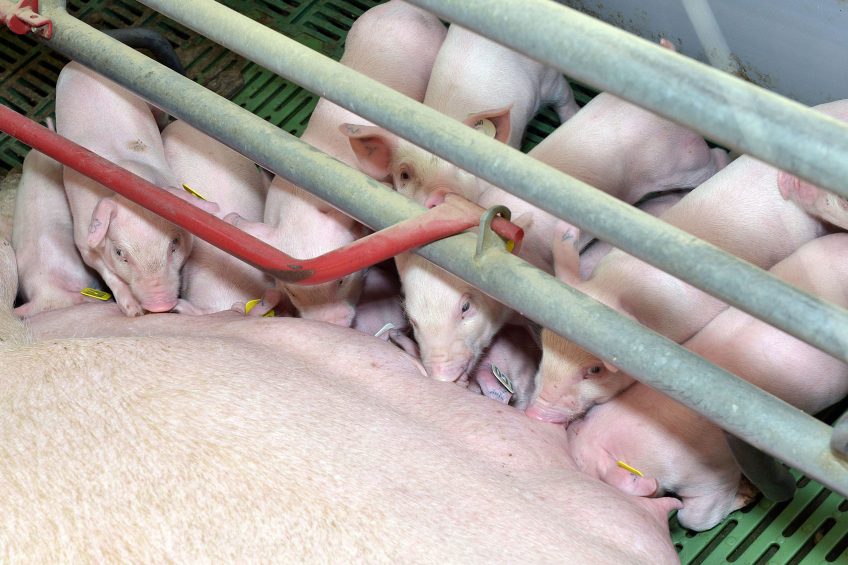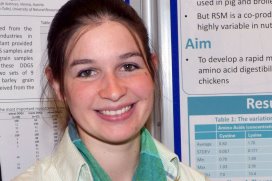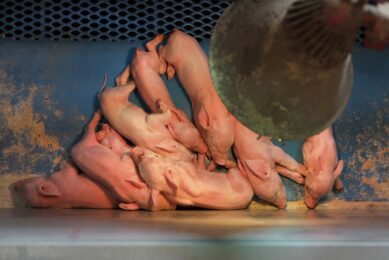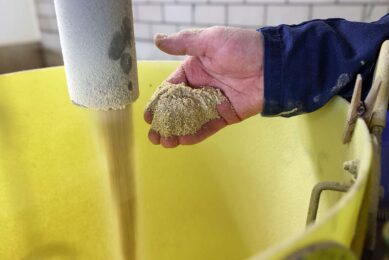What is the maximum weight a sow can wean?

Sows can wean litter weights of over 115 kg at 28 days of age and pigs with low birth weights can have feed efficiency ratios under 2.4 during the finishing period.
Those were outcomes of recent sow and pig potential research at the Agri-Food and Bioscience Institute (AFBI) in Hillsborough, Northern Ireland, UK. The results were shared in a large news release.
In comparison, the news release explained, commercial litter outputs rarely exceed 105 kg and the average feed efficiency of finishing pigs in Northern Ireland is approximately 2.7. The superior performance outputs achieved at AFBI were driven by a combination of nutrition and management and demonstrate the high potential that both sows and low birth weight pigs can achieve.
Piglet birth and wean weights have reduced
The news article explains that it is well known that, due to significant increases in litter sizes over recent years, piglet birth and wean weights have reduced. However, the weaning weight of a pig is a critical factor in determining its life time performance, and therefore a conflict in terms of productivity has arisen.

As part of her postgraduate work at Hillsborough, Dr Aimee Louise Craig addressed this issue, which aimed to develop nutritional and managerial strategies to increase piglet and litter wean weights and optimise the lifetime performance of low wean weight piglets.
Effects of a range of energy and protein levels
These research studies investigated the effect of a range of energy and protein levels in the diet as well as different feed levels during lactation. When a base (control) diet was offered (13.6 MJ DE/kg; 1% total lysine, intake of 7.5 kg/day) sows produced a litter weight of 101 kg over a 28 day lactation.
However, when a diet containing 14 DE MJ/kg and 1% total lysine was fed at the same intake level (7.5 kg/day) sows produced a litter weight of 112 kg. Providing additional valine (an amino acid) did not further increase litter weaning weight. Also phase feeding during lactation only provided a small increase in litter performance, but benefits were outweighed by the cost.
Greatest average litter weaning weight
Over the series of trials, the treatment that produced the greatest average litter weaning weight (115 kg) was when sows were offered a diet containing 15.8 DE MJ/kg and 1.3% total lysine at an intake of 7 kg/d. The total litter weaning weight of 115 kg represented a litter of 13 piglets weighing on average 8.8 kg.
Larger vs smaller pigs
In these trials it was interesting to find that the large pigs responded to the higher production level better than the smaller pigs i.e. regardless of whether a small pig was on a sow which was in the top or middle third of performance, the wean weight of the small pigs in the litter seemed to be capped at approximately 7 kg.
The overall conclusion of the 2 studies was that litter weight was primarily driven by sow feed intake (intakes of over 7 kg/d on average over a 28 day lactation). However when intake was low (6 kg), an increase in diet specification, both energy and lysine levels, resulted in litter weaning weights above 100 kg. All the litter weaning weights were achieved without compromising sow body condition or back fat loss.
Impact of colostrum on piglet performance
The impact of colostrum intake on piglet performance was also examined, and the results showed that sows with heavier litters produced more colostrum. Many studies focus on reasons of mortality but in this study reasons for survival were identified. The work found that although birth weight and colostrum intake were important, the chances of survival to weaning were also closely related to weight gain during 24-48 hours post birth. This work suggests that vigorous piglets that establish teat ownership in the first 48 hours have more chance of survival regardless of birth weight.
With regard to post weaning piglet management, two main rearing practices were compared. Small pigs (about 5.5 kg) were allowed to either suckle the sow for an extra 3 weeks (i.e. weaned at 7 weeks of age), after which they were offered a commercial dietary regime. However due to the 3 week delay in weaning, diet changes took place 3 weeks later than the comparator group, which were weaned as normal at 4 weeks of age and offered the same commercial dietary regime.
Mortality in the extended suckled group
Key differences observed were that most of the mortality occurred in the extended suckled group before they were 10 weeks of age but for the ‘normal’ group most of the mortality occurred in the finishing period. The extended suckled group also had superior finishing pig performance than the ‘normal’ group. As such, the economics of extended suckling and delayed dietary changes was better by £5.40 (€ 6.09) per pig than the practice of weaning small pigs at 4 weeks and offering a special starter diet regime.
Take-home messages
In conclusion, the news release stated that offering lactating sows a diet containing at least 14.4 MJ DE and 1% lysine at an intake of 7.5 kg per day will drive high litter performance. Improving the environment of the farrowing house to encourage high intakes will also improve piglet weaning weight.
Furthermore, there could be economic advantages associated with offering small pigs at weaning (<6 kg) extended suckling coupled with lifetime dietary changes which match weight development.>
The studies were funded by the UK Department of Agriculture, Environment and Rural Affairs (Defra) and the work was completed at AFBI, Hillsborough in conjunction with Queens University Belfast.
 Beheer
Beheer








 WP Admin
WP Admin  Bewerk bericht
Bewerk bericht